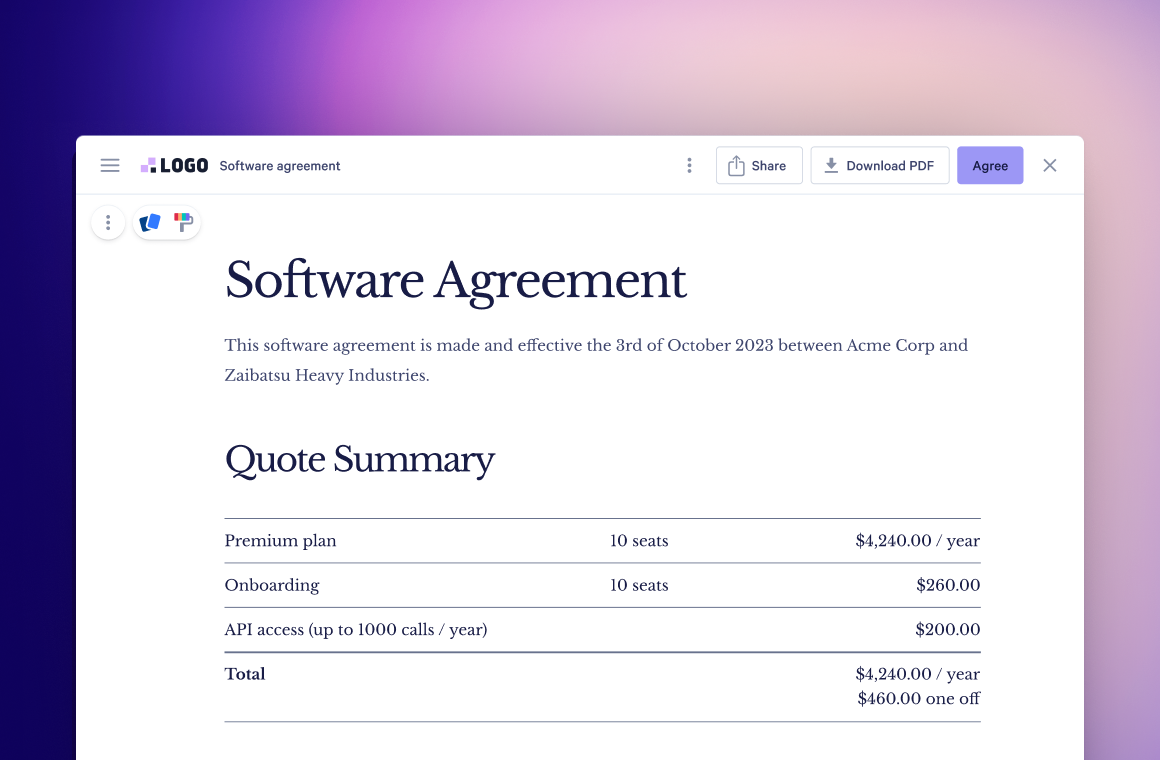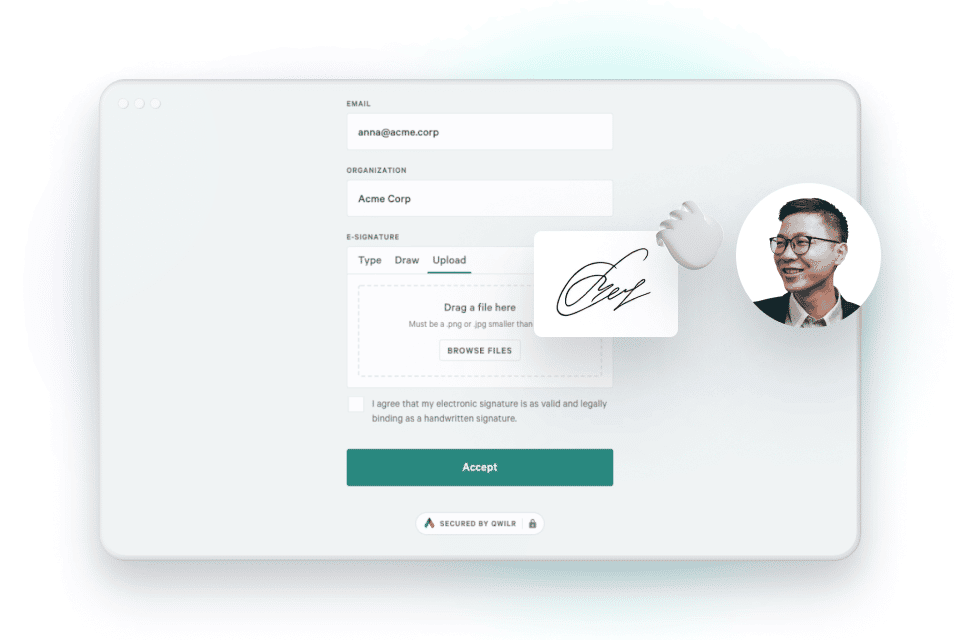Remember when you thought a contract was set in stone, only to realize it can change faster than a traffic light at rush hour? Contracts are the crux of many business dealings, formalizing agreements and setting expectations between parties.
But what happens when circumstances change or additional terms need to be added after a contract is signed? This is where an addendum comes into play: a postscript to the main story of your agreement; a way to append important information without starting from scratch. It doesn’t have to be complicated - we’ll prove it.
Key Takeaways
- An addendum adds or clarifies terms in a contract without changing its original intent, unlike an amendment that replaces or removes terms.
- Use an addendum for significant changes like deadlines, scope, financial terms, or regulatory updates, not for minor corrections.
- Include a title, reference to the original contract, effective date, changes, purpose, signatures, and an optional integration clause.
- Keep formatting consistent, consult legal advice for complex changes, stay specific, and draft contracts with flexibility to minimize addenda.
What is an addendum?
If you’re here, it’s probably because you’re looking for how to add an addendum to a contract. But in the case that a refresher is needed, here’s what an addendum is.
An addendum is a supplementary document that modifies, clarifies, or adds to the terms of an existing contract. Instead of drafting a whole new agreement, an addendum allows the parties to address specific changes while maintaining the original contract’s validity. Addenda are legit - AKA - legally binding, provided they are written clearly, signed by all involved parties, and do not conflict with the original terms.
What an addendum it is not: An important distinction to keep in mind is that an addendum is not the same as an amendment. While both alter existing contracts, an amendment replaces or removes parts of the original agreement, whereas an addendum adds new provisions without changing the existing terms.
When to use an addendum
Teeny changes like correcting typos, formatting issues, or non-substantive errors usually don’t require an addendum. These adjustments can often be handled through simple revisions or mutual agreement without altering the document’s intent. On the other hand, here are things that do require an addendum.
- Changing deadlines: If a project’s timeline shifts due to unforeseen delays or adjustments, an addendum can formalize the new deadlines. For example, in a software development contract, a delay in the testing phase might require updated delivery dates.
- Adding scope: When both parties agree to expand the scope of work, such as additional services, features, or deliverables, an addendum can outline these changes without overhauling the original agreement. For instance, a contractor hired to renovate a kitchen might use an addendum to include the addition of a new bathroom.
- Clarifying ambiguities: Jake saw her duck. Huh? Can you clarify that, please? If the original contract contains vague or poorly worded terms that have led to misunderstandings, an addendum can clarify these points. For instance, a freelance agreement might need an addendum specifying the number of revisions included in the project fee.
- Adjusting financial terms: If payment terms change, such as the introduction of a new milestone-based payment schedule or adjustments to budget or fees, an addendum ensures all parties are on the same page. For example, a real estate agent might use an addendum to outline updated commission percentages.
- Incorporating new regulations: In industries subject to frequent regulatory changes (FYI - sectors that are closely monitored due to their impact on public safety, privacy, the environment, and economic stability), an addendum can ensure the contract remains compliant. For example, new data protection laws may require additional clauses in a vendor agreement.
In essence, an addendum is appropriate when the changes are specific and do not fundamentally alter the nature of the original contract. If the alterations are extensive, drafting a new agreement may be more practical.
Real-world applications and examples
There’s nothing like a “real life” example to get you comparing your own situation. These scenarios should shed some light on how addenda are applied across different industries.
- Construction projects: Imagine a contractor agrees to build a house but later, the homeowner decides to include a swimming pool. Instead of rewriting the entire contract, an addendum can outline the new scope of work, costs, materials, and timelines for the pool. This avoids unnecessary confusion and keeps the process streamlined.
- Employment agreements: In the dynamic world of employment, contracts often require updates. For instance, an addendum can be used to include new benefits, revise job responsibilities, or adjust compensation based on a promotion. This ensures that changes are documented without invalidating the original employment agreement.
- Real estate transactions: Addenda are common in real estate. For example, a buyer might request an addendum to a purchase agreement that includes specific contingencies, such as the completion of certain repairs before closing or the inclusion of additional furniture in the sale.
- Freelance work: A freelance writer or designer might initially agree to deliver three drafts of a project. If the client later requests additional revisions, an addendum can outline the terms, deadlines, and additional compensation for the extra work.
- Partnership agreements: In business partnerships, evolving needs often lead to new arrangements. For example, an addendum can be used to revise profit-sharing ratios, outline new responsibilities, or incorporate additional partners into the agreement.
These examples highlight the flexibility and practicality of addenda in adapting to changing circumstances while maintaining the integrity of the original agreement.
What to include in an addendum
A well-drafted addendum must be thorough and precise to avoid misinterpretation. Here’s a detailed breakdown of the essential components:
- Title and reference: Clearly label the document as an “Addendum” and provide a reference to the original contract. For instance, use a title like “Addendum to the Service Agreement dated [Original Contract Date].” Two things you’re ensuring here: clarity and easy identification.
- Effective date: Specify the date the addendum comes into effect. This prevents any smoke and mirrors about when the new terms apply.
- Parties involved: Identify the parties to the original contract, ensuring consistency with their legal names and roles as stated in the original agreement (otherwise, that might be embarrassing?) Company names and titles are also important here!
- Purpose: Provide a concise explanation of why the addendum is being created. For example, “This addendum is created to update the project completion timeline due to unforeseen delays.”
- Details of the changes: Arguably the most important part - outline the specific changes, additions, or clarifications. Be as detailed as possible to avoid future disputes. For instance:
- “Section 4.1 of the original contract is hereby amended to extend the delivery date from March 31, 2025, to April 30, 2025.”
- Use bullet points or numbered sections to enhance readability.
- Integration clause (optional): Include a clause confirming that the original contract remains valid except as modified by the addendum. For example, “All other terms and conditions of the original agreement shall remain in full force and effect.”
- Signatures: A signature moment. Require all parties to sign and date the addendum. Without signatures, the document is not legally enforceable.
- Witness or notary (if applicable): In some cases, especially for the high flyer contracts, having a witness or notary sign the addendum can provide additional legal validation.
By including these elements, your addendum will be clear, enforceable, and seamlessly integrated with the original contract.

How to write an addendum: key steps
Creating an effective addendum requires careful planning and attention to detail. Here are the key steps:
- Review the original contract: Fine tooth comb! It seems quite obvious but it’s often underestimated: Thoroughly read the original contract to ensure you understand its terms and structure. This helps avoid inconsistencies or confusing contradictions.
- Identify the changes: That’s how you got here after all. Clearly define what needs to be updated, added, or clarified. Be specific to avoid any potential misunderstandings. For example, identify whether the change relates to timelines, scope of work, payment terms, or other aspects.
- Draft a clear title: We said it before and we’ll say it again. Use a descriptive title like “Addendum to [Contract Name] Dated [Original Contract Date]” to ensure clarity.
- Reference the original agreement: Include a reference clause that connects the addendum to the original contract. For instance, “This addendum is made pursuant to the Service Agreement dated January 1, 2025, between [Party A] and [Party B].”
- Write the modifications: Time to walk the walk. Clearly outline the changes or additions. Use structured language and consistent formatting for precision. For example:
- “Section 2.1 is amended to include the following additional deliverables:”
- “(a) A detailed market analysis report…”
- “(b) A presentation summarizing key findings…”
- “Section 2.1 is amended to include the following additional deliverables:”
- Include legal language: You might want to add an integration clause, if necessary, to confirm that the original contract remains valid except for the changes outlined in the addendum.
- Proofread for accuracy: This is one thing you’ll want to proofread. Carefully review the addendum for errors, inconsistencies, or ambiguous language (Did Jake see her physically duck, or did she own a duck? Still can’t be sure). A second set of eyes can be invaluable.
- Obtain signatures: The deal isn’t sealed until this happens. Plain and simple - must be done
- Distribute copies: Provide all parties with signed copies for their records. This ensures you’re all, quite literally, on the same page.
We’ve looked at when to write an addendum, how to write it and what to include. Hopefully, by now you’re pretty much in the know…

5 practical tips for drafting an addendum
A couple more nuggets of info: Drafting an addendum is as much an art as it is a science. These practical tips will help you avoid the ol’ standard blunders:
1. Use consistent formatting: Match the style and formatting of the original contract. This creates a professional and cohesive document.
2. Seek legal advice: If the changes are complex or high-stakes, consult a lawyer to ensure the addendum is legally sound. Legal oversight can save time and money in the long run.
3. Avoid overloading: Keep the addendum focused on specific changes. If you find yourself rewriting large portions of the original contract, it may be better to draft a new agreement.
4. Stay professional: Avoid emotional or informal language. Remember, an addendum is a legal document, not a casual memo.
5. Plan ahead: Anticipate potential changes when drafting the original contract. Including flexibility clauses can reduce the need for frequent addenda. (Quite the gem of a tip this one).
One last thing: let’s be forward-thinking
Warren Buffett says, "In the business world, the rearview mirror is always clearer than the windshield.
To truly grow and thrive, businesses must look beyond the rearview mirror and keep their eyes on the road ahead, anticipating future trends and shaping strategies that ensure long-term success. When adding an addendum, consider these aspects:
- Unconventional use cases: Addendums can apply to personal agreements, gig work, and remote contracts, offering flexibility in various situations.
- Ethics and transparency: Ensure addendums are fair and clear to avoid disputes and maintain ethical standards in your contracts.
- Future flexibility: Draft contracts with room for future amendments to save time on future revisions.
- Tech solutions for management: Use contract lifecycle management software to track changes and stay organized.
- International considerations: For cross-border contracts, ensure addendums comply with local laws and regulations.
- Dispute resolution: Include clear dispute mechanisms in your addendum to resolve conflicts proactively.
By staying ahead of technological advances and maintaining fairness, your addendums will remain efficient, adaptable, and legally sound in an ever-changing world.
Smooth sailing contract changes with Qwilr
Now you can seamlessly incorporate agreements into your Qwilr pages.
For some businesses, contract proposals must include specific conditionals and a binding contract. With our agreements feature, Qwilr users can effortlessly meet those needs. By adding an agreement, you can offer your prospects a concise, professional outline of your terms.
But that’s not all: The agreement goes perfectly hand in hand with your proposal - so - two birds, one stone kind of thing.
Here’s how easy it is to add an agreement:
1. Create or open your proposal in Qwilr
2. Add an accept block and choose to 'add an agreement'

3. Choose from the pre-set agreement templates which you can customize, or start with a blank template

4. Customize the terms and details and save it as a template to use again in the future.
5. Share your impressive interactive proposal and plain-text agreement and get your prospects to sign on the dotted line.
Sales amplified by Qwilr
The legalities of writing an addendum shouldn’t scare you off. Yes, it’s an upgrade of the contract. Yes, with some deep focus and proofreading, you can nail it.
At the end of the day, you are creating a legally binding document that serves everyone’s best interests. Whether you’re a contractor, freelancer, or business owner, mastering the art of writing an addendum will make you as adaptable a yoga instructor in a tornado. After all, in the world of contracts, flexibility is often the key to success.
For a shot at success, sign up for our free trial to see all the gains that Qwilr has to offer.
About the author

Brendan Connaughton|Head of Growth Marketing
Brendan heads up growth marketing and demand generation at Qwilr, overseeing performance marketing, SEO, and lifecycle initiatives. Brendan has been instrumental in developing go-to-market functions for a number of high-growth startups and challenger brands.


